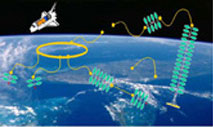Robot Space Cowboys

Schematic diagram of architecture of self-assembling solar power satellite. Seeker "whip" units, (yellow) powered at both ends, listen for signals from subassemblies, find them, and pull them together.
A unique University of Southern California design for self-organizing robots controlled by “hormonal” software is moving toward space.
At the Robosphere 2002 conference held at the NASA Ames Research Center in Silicon Valley November 14-15, Wei-Min Shen of the USC School of Engineering’s Information Sciences Institute (ISI) presented an overview of an audacious project to have pieces of the proposed half-mile-long Space Solar Power System satellite put themselves together–self-assemble–without the help of astronauts.
Shen and co-principal investigator Peter Will are doing more than proposing. They are already testing the hardware and software the system would use in the ISI Polymorphic Robotics Laboratory, of which Shen is director.
Over the past two and a half years, Shen and Will have developed modular individual robot units, each with a computer chip programmed with what the researchers call “hormonal” software. Shen said that such software allows “bifurcation, unification, and behavior shifting” by the modules.
The units can unite themselves into larger wholes, or divide themselves up into smaller ones. “If a six-unit snake splits in half,” explained Shen, “you get two smaller, three-unit snakes that function as the larger one did.”
Separated units communicate using infrared signals, maneuvering their coupling units into a lock in cooperative, coordinated fashion.
“Behavior shifting” means that the individual units–which are identical–exhibit different behavior according to their position in the assembly.
Will and Shen’s CONRO project created working units that use the software. Shen and Will’s new SOLAR space station proposal, funded by a consortium including NASA, the NSF, and the Electric Power Research Institute (EPRI), proposes to use this architecture on a gigantic scale.
They propose a self-assembling space station consisting of two species of robotic devices, both controlled by the same software.
One species will be the parts that will actually make up the station: solar power units, including necessary utility conduits. Each of these will have a microprocessor running hormonal software. Sets of contiguious units will, once released into space, arrange themselves into the desired configuration.
When these subassemblies are ready, they will signal and alert the second species of robot, the “free-flying intelligent fiber rope matchmaker units,” or whips.
Whips will consist of two modular robot units connected by a long connector line that can shorten or lengthen at the direction of the software. They will also have solar-powered rockets, enabling them to move in space, GPS sensors to find their position, communicators, and connectors.
When a completed subassembly signals, a whip will maneuver toward it, lock on, wait for a call from a second assembly, tow the first over, pull them together by winching in the fiber rope, so that the two can attach to each other.
Once mating accomplished, the whip unit would then fly off to find other parts to assemble.
The design, said Will, combines the advantages of free-flying and tethered systems.
In the laboratory, Shen and Will have modeled the concept in two-dimensional form, working with an air-hockey table on which prototype individual units will learn to find each other by sensing each other’s infrared signals, maneuver next to each other using built-in fans, lock on, and pull units together using a motorized cable.
“This will give both the hardware and software a realistic test,” said Shen. Researcher Harshit Suri has built a first prototype unit.
Shen and Will won the grant from the NSF/NSA/EPRI consortium that funds their work in a rigorous competition in which 76 proposals were received and only four were funded.
Shen, Will, and ISI collaborator Behnam Salemi published a detailed paper, “Hormone-Inspired Adaptive Communication and Distributed Control for CONRO Self-Reconfigurable Robots,” in IEEE Transactions on Robotics and Automation. in October, 2002. They have recently applied for a U.S. patent on the technology.
Working with Shen and Will in the field of space assembly are two faculty members from the USC School of Engineering: Berokh Khoshnevis of the department of industrial and systems engineering; and George Bekey, of the department of computer science. Along with Suri and Salemi, Yusuf Akteskan is working on the space system project.
The ISI Polymorphic Robotics Laboratory is one of six laboratories associated with the USC School of Engineering’s Center for Robotics and Embedded Systems.
Contact: Wei-Min Shen, shen@isi.edu , (310) 448-8710 .
Media Contact
All latest news from the category: Process Engineering
This special field revolves around processes for modifying material properties (milling, cooling), composition (filtration, distillation) and type (oxidation, hydration).
Valuable information is available on a broad range of technologies including material separation, laser processes, measuring techniques and robot engineering in addition to testing methods and coating and materials analysis processes.
Newest articles

First-of-its-kind study uses remote sensing to monitor plastic debris in rivers and lakes
Remote sensing creates a cost-effective solution to monitoring plastic pollution. A first-of-its-kind study from researchers at the University of Minnesota Twin Cities shows how remote sensing can help monitor and…

Laser-based artificial neuron mimics nerve cell functions at lightning speed
With a processing speed a billion times faster than nature, chip-based laser neuron could help advance AI tasks such as pattern recognition and sequence prediction. Researchers have developed a laser-based…

Optimising the processing of plastic waste
Just one look in the yellow bin reveals a colourful jumble of different types of plastic. However, the purer and more uniform plastic waste is, the easier it is to…



